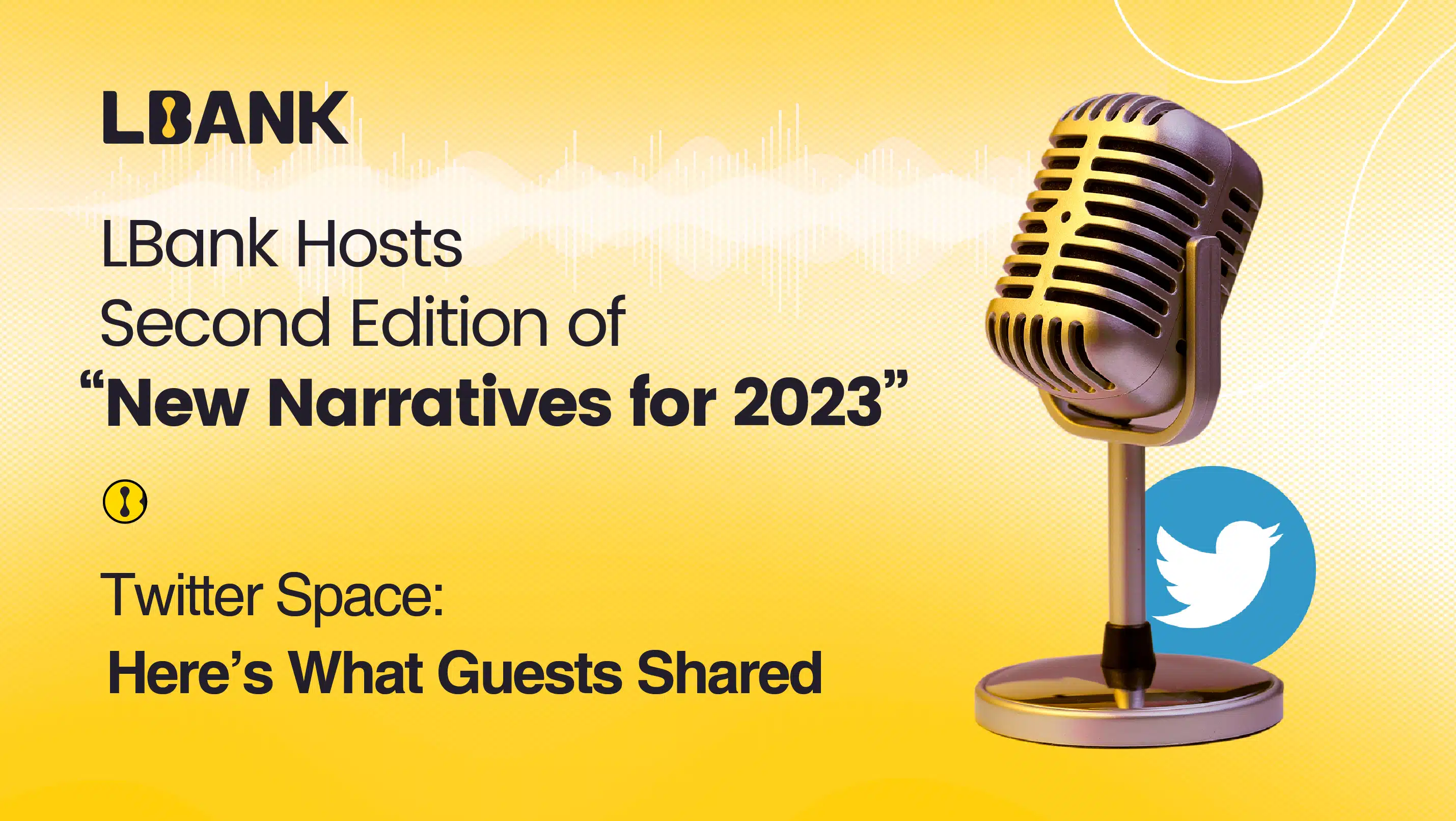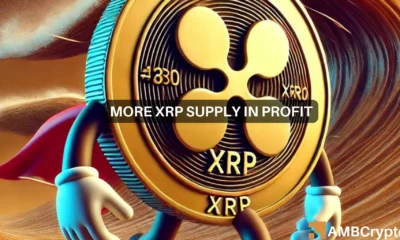LBank hosts second edition of “New Narratives for 2023” Twitter Space

On March 16th, global crypto exchange LBank launched the second volume of the online AMA event “Exploring New Narratives for 2023” through its official Twitter account. The first edition in February pulled in over 40,000 listeners. This article compiles what industry experts had to say about the future of crypto and blockchain.
1. Rainlands, AMA Host, GemPad
LBank: How is 2023 working out for GemPad?
Rainlands: It seems that the market has been slowly picking up since January 2023 and more projects are trying to raise funds. The second quarter of 2023 is expected to continue this trend, and sales have been piling up, leading to a higher success rate. However, it’s hard to predict how the remaining quarters of 2023 will perform. Education is essential, and newcomers should be educated about the space to brush up on their stances and views. The overall outlook for 2023 is optimistic, with a slight dip expected during the last quarter due to the holiday season.
LBank: Was there a dramatic decrease in sales or a change in the DeFi launchpads’ fundraising process due to the recent bankruptcy of Silicon Valley Bank and Signature Bank?
Rainlands: We did not have any sales planned over the weekend, and we coordinated with the projects we were in talks with to postpone any sales. However, sales have been consistent, and we are glad that everything is going well.
2. Dan Tran, Head of business, NFTGo
LBank: What do you make of SVB’s bankruptcy?
Tran: SVB is a popular choice for banking services among tech startups and venture capital firms due to its focus on serving the needs of these specific companies. The recent issues with SVB stem from their investment in long-term securities with a 1% interest rate, which became a problem when a bank run was triggered by investors pulling their money out. This caused the bank to liquidate these securities to return depositors’ money, leading to liquidity issues. The fractional reserve system makes banks vulnerable to bank runs, which can be a significant problem even for larger banks.
I believe it is not the end of the trouble yet. The extreme interest hikes by the Federal Reserve has also affected banks like Credit Suisse and First Republic Bank. The Federal Reserve may buy held-to-maturity securities at a purchase price to prevent banks from collapsing, as many banks are holding undervalued securities due to the significant increase in interest rates from last year to this year.
The bank did not manage its risks well and should have hedged its position. Due to bankruptcy, they had to return deposited money and liquidate their long-term securities, which lost value due to increased interest rates. The bank did not have enough equity to compensate for these losses, leading to its collapse.
3. NNOVA.eth, Social Media Manager, Saito Network
LBank: Why didn’t SVB react at the right pace as the interest rate went up? Also, what do you think of the current state of crypto regulation?
NNOVA.eth: I would argue that the Fed’s actions led to the current situation, rather than poor management by the banks. In light of recent events, such as the LUNA crash and the stablecoin crisis, regulation is not necessary in decentralized systems where there is less need for intermediaries and humans running the platforms. Instead, the code is to be trusted to do what it is supposed to do, and Bitcoin is also regulated by its consensus.
The financial system is highly regulated but has proven to be unreliable and prone to boom and bust cycles. We should build new models of decentralized and open systems that make the old models obsolete. Just look at the first transaction in the Bitcoin Genesis block, which included a message against the old financial model. It urged us to not let the new decentralized system become an appendix of the old centralized model.
4. Seattle Smith, Founder & CIO, Baus Capital
LBank: What do you think of the institutional environment for projects that are fundraising? How are those efforts going?
Smith: The fundraising environment for Web3 projects and those participating in the digital asset ecosystem is currently challenging. There is a reduced amount of cash available to be deployed, and many VCs and private investors have pulled back. This has resulted in a significant number of companies dying off or greatly diminishing, but there are still new emerging projects in the space.
However, there may be some consolidation. Investors are demanding high standards from startups. Despite the difficult fundraising environment, it is still a good time to launch innovative projects in this space. Our fund, Baus Capital, is facing similar challenges, and there is a demand on the LP side and managed account side to deploy capital to their strategies. Their approach to building technology and working with teams that are focused on problem-solving and innovation emphasizes the need to find investors who understand the long-term goals of their project.
5. Kenny Li, Co-Founder, Manta Network
LBank: What are your thoughts on on-chain privacy?
Li: On-chain privacy is growing ever so important in the crypto space, especially as real activity flows in. Zero-knowledge proofs have tremendous value in providing privacy, and I am always happy to discuss launching privacy tools in the crypto space.
LBank: What does the roadmap of multi-chain look like?
Li: Interoperability is becoming more prevalent in projects that aim to connect different blockchains and address the issue of different blockchains being in silos. Multi-chain solutions that offer privacy preservation need to be developed. Users should not have to actively migrate their tokens from one ecosystem to another. The challenges of building an ecosystem lies mostly in how it requires a fine balance between user incentives and value alignment. We are exploring sustainable ideas for building our own ecosystem.
6. Crypto Meina, Founder of Crypto Meina Podcast
LBank: What will be the narrative for DeFi in 2023?
Crypto Meina: I can see an uptick in the market due to macroeconomic concerns and uncertainty surrounding inflation rates. However, I don’t focus on short-term pricing, and financial infrastructure needs to be improved in DeFi, particularly the trading experience and professional options.
The emergence of new alternative layer solutions and increased throughput scale could lead to more revolutionary trading products. I’m also bullish on income-backed solutions like protocols that tokenize future cash flows, such as Homa Finance and Debt Doll. GMX is also doing great with its innovative decentralized perpetual platform and incentive balance.
7. Mikhail Y., Web3 Consultant, CertiK
LBank: What are going to be this year’s most ground-breaking changes in DeFi from CertiK’s auditing perspective?
Mikhail: The activity we’re seeing on layer 2 scaling solutions on top of Ethereum and Cosmos, including the number of developers working on the sub-ecosystems versus the actual chain, is mind-boggling. But there are still some red flags in the space, specifically with regards to rug pulls and projects’ use of Namecheap for website registration, as it does not require any personal information to be shared. The median lifespan of rug pull projects is around 57 days, but some last around 300 days.
False claims of charity or partnerships, get-rich-quick schemes, and the absence of a roadmap or whitepaper are some of the more obvious red flags. But there are also anonymous or semi-anonymous team presentations, which can be a red flag for some investors. It’s important to analyze a project’s development and security before investing. Projects should provide insights into the current state of development on various blockchain ecosystems such as Ethereum, Cosmos, and Solana.
8. Hamilton Keats, Co-Founder, Krayon
Q: What do you think about the current state of crypto regulation?
Keats: I’m keeping a close eye on the regulations regarding centralized custody and self-custody solutions for crypto projects. Singapore is doing a great job on this because of its favorable regulatory framework. Regulators in Singapore are planning to put a framework for crypto custody in place within the next 18 months. I see a lot of uncertainty and lack of clarity in the US and Europe, which leaves companies exposed. Regulation is necessary to provide clarity and confidence in the crypto space.
However, I’m excited about the prospect of more real-world assets moving onto private blockchain networks, such as tokenized funds, and I believe that everyone in the crypto space will need a custody solution or private key management.
LBank is preparing the next “Exploring New Narratives for 2023” Twitter Space. If you are interested in participating, don’t hesitate to contact us.
Google Form: https://forms.gle/CyuUDyzynGSngVSG8
Email: sara.shen@lbank.info
TG: @frankiessara (https://t.me/frankiessara)






